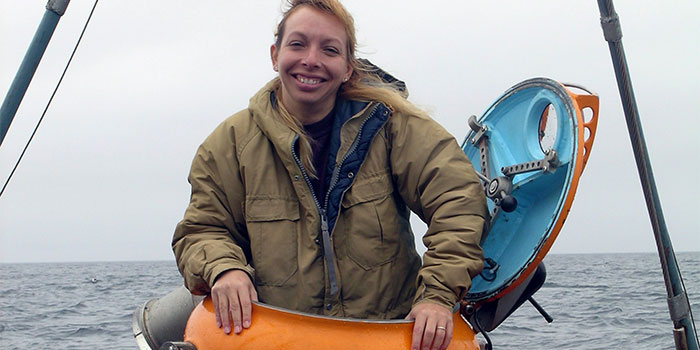
Meet Christina Kellogg
Dr. Christina Kellogg is a research microbiologist with the U.S. Geological Survey, who studies the microbes found on corals. Read the full text of Christina's interview below to learn more about her job.
About the Job
What is your title?
Research Microbiologist.
Where do you work?
U.S. Geological Survey, part of the Department of Interior.
Do you travel often? To where?
Yes! It’s one of my favorite parts of my job. I travel for field work to collect samples—places have included the Aleutian Islands, Barbados, the Gulf of Mexico, the Virgin Islands, and American Samoa. I also travel to attend conferences to present the results of my work. This has taken me to China, Germany, Norway, the Netherlands, and all over the United States.
What are the educational requirements for your job?
Having a Ph.D. and post-doctoral experience.
What is the salary range for someone with your type of job?
I am a principal investigator with my own lab; on federal pay scales, the range is about $60,000 - $130,000, annually.
How many hours do you work per week?
I normally work a 40-hour week. During a research cruise, it becomes more like 80-100 hours a week.
Job Duties
Tell us about your research and the types of things you do.
I am an environmental microbiologist, which means I study microscopic organisms in nature (as opposed to clinical microbiologists who work in hospitals). My lab is currently focused on the microbes associated with corals, both tropical shallow-water species and deep-sea species. Just like people have bacteria on their skin and in their guts without which they would not be healthy, corals also have their own microbes that are part of their healthy biology. I use classic microbiological tools and modern molecular methods to identify those microbes (i.e., figure out who’s there) and then try to determine what they are doing, to better understand coral biology BEFORE a disease outbreak rather than after.
What is the most fascinating thing you have ever seen or done?
Having the opportunity to make dives in both the Delta and the Johnson-Sea-Link submersibles has definitely been a career highlight. It is incredible to be over a thousand feet underwater, actually seeing the deep-sea corals you work on in their natural habitat, knowing on each dive you may be seeing something that no one else has ever laid eyes on.
What are the personal rewards of your work?
I enjoy the variety of sometimes doing lab work, sometimes being in the field collecting samples, and sometimes being at my desk doing analysis and writing. I love that I meet and work with scientists from all over the world who are passionate about what they do. And it is a huge bonus that I get to travel all over the world.
How does your work benefit the public?
By discovering new biodiversity (at the microbial level) and by teasing out one part of the puzzle of how coral ecosystems function.
What else could someone with your background do?
The microbiology and molecular biology techniques I use for environmental samples are also used in clinical laboratories, biotechnology companies, and pharmaceutical companies. Since I have an academic background, I could also teach at the high school, community college, or university level.
About Christina
What sparked your initial interest in ocean sciences?
I grew up on a boat in the Caribbean, surrounded by the ocean.
Who influenced you or encouraged you the most?
My ‘role-model aunt’ Dr. Judith Connor, a phycologist (person who studies algae) who currently works at the Monterey Bay Aquarium Research Institute, and my high school marine biology teacher, Mr. Mark De Bie.
Looking back, was there anything you would have done differently in your education or career journey?
It would have been great to work in a laboratory as an undergraduate. Instead, I had a work-study job in an office. I think early exposure to the lab gives you amazing preparation for graduate school and helps you find out whether you love it or not before you commit to graduate school. So I make it a point to make time for undergraduate interns to work in my lab so that I can give them that opportunity.
What obstacles did you encounter along the way?
The usual—experiments that didn’t always work or took months instead of days and being a poor graduate student subsisting on Ramen noodles.
What are your hobbies?
Reading science fiction, learning to make stained glass panels, underwater photography.
Published September 11, 2013